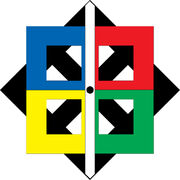Tag: rte-wysiwyg |
No edit summary Tag: rte-wysiwyg |
||
| Line 2: | Line 2: | ||
The '''Songahm Star''' is the name given to the ''floor pattern'' of the forms ("poomsae") used in [[ATA Taekwondo|ATA-style]] taekwondo. In other words, when the practitioner performs an ATA-style form, these are the lines on the ground that he or she follows as he or she moves through the form. The forms used in ATA-style taekwondo are called [[Songahm]] forms. |
The '''Songahm Star''' is the name given to the ''floor pattern'' of the forms ("poomsae") used in [[ATA Taekwondo|ATA-style]] taekwondo. In other words, when the practitioner performs an ATA-style form, these are the lines on the ground that he or she follows as he or she moves through the form. The forms used in ATA-style taekwondo are called [[Songahm]] forms. |
||
| − | The star is a symmetrical eight-pointed star. The distance between the middle of the star and the top of the star should be 9 foot- |
+ | The star is a symmetrical eight-pointed star. The distance between the middle of the star and the top of the star should be 9 foot-steps. When performing Songahm forms, the starting position is assumed to always be facing east; this is intended to be symbolic of respecting taekwondo's origin in Korea (the east). |
== Symbolism == |
== Symbolism == |
||
Latest revision as of 00:40, 3 March 2015

The Songahm Star
The Songahm Star is the name given to the floor pattern of the forms ("poomsae") used in ATA-style taekwondo. In other words, when the practitioner performs an ATA-style form, these are the lines on the ground that he or she follows as he or she moves through the form. The forms used in ATA-style taekwondo are called Songahm forms.
The star is a symmetrical eight-pointed star. The distance between the middle of the star and the top of the star should be 9 foot-steps. When performing Songahm forms, the starting position is assumed to always be facing east; this is intended to be symbolic of respecting taekwondo's origin in Korea (the east).
Symbolism[]
The late founder of ATA/Songahm taekwondo, Haeng Ung Lee, described the Songahm Star as being an example of a day in the life of a person:
- "Life has a center point. Everything on earth has a center point. This is where we obtain our balance. The center point of the human being is the heart, physically, emotionally and spiritually. The completed forms form a star with a center point and eight outer points, which create a circle if connected. This is the circle of life.
- "Each day we live, completes a circle: we rise in the morning from our place of rest; then, we go through the day accomplishing our goals and overcoming obstacles that life puts in our way; and, when evening comes, we return to our place of rest. We constantly try to improve this circle. We go to work or we go to school. Why? Because this is the way we complete the best circle. We try to have the best life. Study gives us knowledge that we can apply to make a living. The job is the resource we use to make that living. Diligent study and a good job results in a good pattern or 'poome-sae' in our life.
- "Not only is the circle seen in day to day activity, but also in our entire life itself. We come from the dust of the earth and our bodies return to the dust of the earth. During the span between birth and death, we move throughout life setting and accomplishing goals. This is the reason all forms begin and end at the same spot."
- "As we complete each form, we must imagine ourselves drawing a circle freehand. No one can draw it perfectly the first time, We just try to close the circle and then we adjust and refine it to make it perfect. It is the same way we must face life. We're not going to make it perfect. However, we can strive to correct the flaws as we move along. We must complete the circle, the 'Winner's Circle'."
- If a student is not aware of the place to begin or end the form, nor has a plan of action to get through the process, how can the student achieve the desired result? The same is true for success in life. Here are Grand Master Lee's words concerning this philosophy: "If a person does not know where to begin or end in life (setting goals), then that person will become confused when given a choice between two paths."